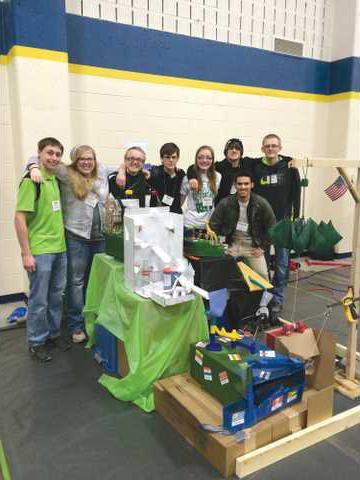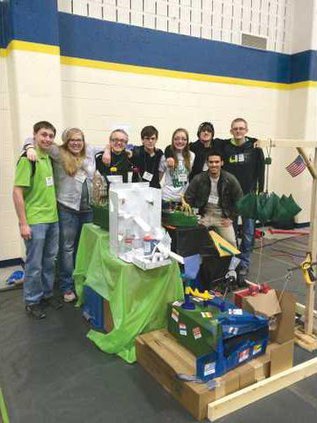BENTON/HAZEL GREEN—Science has simplified life’s daily chores over the years and students have been challenged to once again complicate the process of a common task using science, technology, engineering and math (STEM) skills to compete in the Rube Goldberg Machine Contest.
Rube Goldberg, a Pulitzer Prize-winning cartoonist, sculptor, author and engineer, spent the early part of his career making “inventions” to tackle basic tasks. He is best known for his zany invention cartoons featuring many complicated steps to accomplish the simplest task.
The first competition began as a contest between two engineering fraternities of Purdue University in 1949, at the peak of the Goldberg era. The contest died out in 1955 and was resurrected in 1983 after several decades without a competition. In 1988, the first national Rube Goldberg Machine Contest was launched, challenging students to take an elementary task and provide a complex, convoluted solution using ordinary objects, mechanical gadgets and miscellaneous odds and ends connected together to achieve a specific goal. The 2016 regional competition was held at the Waukesha County Technical College.
“The STEM skills and imagination high school students use to make their machines is impressive, along with their creativity, energy and teamwork,” Mark Rzeznik, Waukesha County Technical College associate dean of graphics and engineering technologies, said.
The main goal of the Rube Goldberg Machine Contest is to encourage critical thinking and problem solving in a non-traditional learning environment.
This year’s challenge was to open an umbrella. Opening an umbrella is a simple, straightforward task, but to accomplish it in 20 steps or more makes it more of a challenge. To achieve such a task takes trial and error, patience, strategy and a good dose of humor.
On Friday, March 4, approximately 250 Wisconsin high school students and instructors on 17 teams from high schools throughout the state competed and displayed their umbrella machines. Teams of up to 12 high school students and two teachers demonstrated their engineering skills. Both Benton and Southwestern high schools had teams competing.
Southwestern High School has participated in the contest in the past, although this year’s participants, all from the physics course, were all new to the contest. Benton High School was new to the event this year and earned the Rookie of the Year award, placing 12th out of 17 teams.
“We got some great ideas for next year,” Jennifer Bartels, Benton High School math teacher said. “Next year’s goal is to get in the top 10.”
Southwestern’s team finished 15th this year.
“We knew that winning the regional was probably not in our capabilities,” Rachel Evanoff, Southwestern High School science teacher, said. “Other schools simply have more available man hours that their kids can give. But, we really wanted to do well in the Risk category.”
The school had won the Risk Award for three years in a row, featuring the machine with the riskiest elements. The award led the team to take the steps it did to construct its machine.
“Had our machine ran smoothly for even one run, we could have finished considerably better,” Evanoff said. “We did do well on the theme portion of the competition, which surprised us. We were the only team to have “superstitions” as an overall theme, and this allowed us to score fairly well in that category.”
The students featured several superstitions in their machine, both good and bad ones, with the worst being opening an umbrella indoors at the end.
Benton’s team chose the theme of ‘around the world and end in Benton, Wis., North America.’ Students commented that they liked when their machine worked, when they finally heard the swoosh of the umbrella opening. The didn’t like the trial and error process and making all of the adjustments to get the machine to work properly. Bartels said the hardest part was the time management and the stress. Students worked on the project twice a week from December to February and five times a week from February until the competition in March.
“The students had to learn to work as a team and found out how important competition is, how important engineering is and the design,” Bartels said.
The completed machine must fit in an overall volume of 250 cubic feet and run for no more than two minutes per run.
“Students learn teamwork, basic physics principles, time management, problem solving and how to think ‘outside the box,’ so to speak,”
Evanoff said since school started students have spent an hour a week on the project. They started by choosing the theme, drawing plans, securing the materials, constructing the machine and adjusting parts to ensure it works properly.
“The majority of the man hours are spent on the construction, and sometimes reconstruction, of the machine itself,” Evanoff said. “Some of the steps didn’t go as planned and we had to re-think our strategy. This is where the teamwork and ability to think outside the box came in.”
Transporting the machine across the state to the competition is another obstacle that has to be factored into the design.
“Some of our steps didn’t travel well,” Evanoff said. “Making adjustments on the go was difficult. Our first two runs saw the front half of our machine work well, while the back half didn’t work. Our third run, after many adjustments, saw the back half of our machine work well, while the front half didn’t work. This was frustrating for our team.”
Evanoff said the Southwestern students were very competitive and did not like not winning.
“There are lots of things to learn from the day, including how to trust and work with each other, flexibility and confidence of the machine that they completed,” Evanoff said. “It was a very eye-opening experience to see large schools, whose kids focus just on their Rube machine, and the intricately complicated machines that they construct.”
Southwestern’s team consisted of 11 seniors, all taking physics. Benton’s group consisted of a broader range of students: two seniors, three juniors and three sophomores. Both programs are open to any students at the two schools who are interested. Benton's team was also coached by science teacher Roxanne Boardman.





